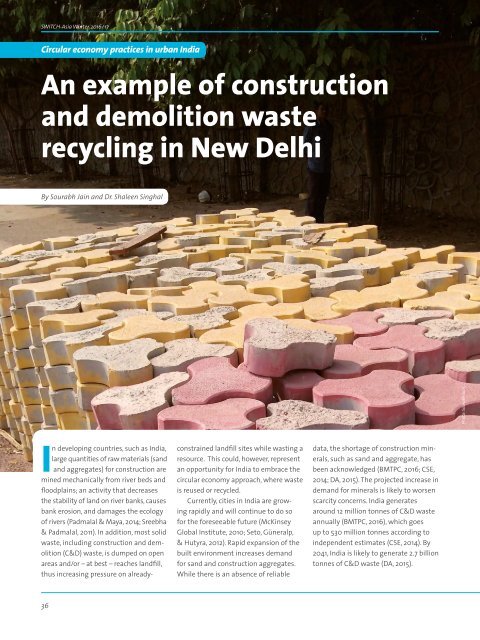SWITCH-Asia MAG Winter 2016/17 on Circular Economy. (c) SWITCH-Asia Network Facility. Design: Elmar Sander and Katharina Olma
You also want an ePaper? Increase the reach of your titles
YUMPU automatically turns print PDFs into web optimized ePapers that Google loves.
<str<strong>on</strong>g>SWITCH</str<strong>on</strong>g>-<str<strong>on</strong>g>Asia</str<strong>on</strong>g> <str<strong>on</strong>g>Winter</str<strong>on</strong>g> <str<strong>on</strong>g>2016</str<strong>on</strong>g>/<str<strong>on</strong>g>17</str<strong>on</strong>g><br />
<strong>Circular</strong> ec<strong>on</strong>omy practices in urban India<br />
An example of c<strong>on</strong>structi<strong>on</strong><br />
<strong>and</strong> demoliti<strong>on</strong> waste<br />
recycling in New Delhi<br />
By Sourabh Jain <strong>and</strong> Dr. Shaleen Singhal<br />
Photo: Sourabh Jain<br />
In developing countries, such as India,<br />
large quantities of raw materials (s<strong>and</strong><br />
<strong>and</strong> aggregates) for c<strong>on</strong>structi<strong>on</strong> are<br />
mined mechanically from river beds <strong>and</strong><br />
floodplains; an activity that decreases<br />
the stability of l<strong>and</strong> <strong>on</strong> river banks, causes<br />
bank erosi<strong>on</strong>, <strong>and</strong> damages the ecology<br />
of rivers (Padmalal & Maya, 2014; Sreebha<br />
& Padmalal, 2011). In additi<strong>on</strong>, most solid<br />
waste, including c<strong>on</strong>structi<strong>on</strong> <strong>and</strong> demoliti<strong>on</strong><br />
(C&D) waste, is dumped <strong>on</strong> open<br />
areas <strong>and</strong>/or – at best – reaches l<strong>and</strong>fill,<br />
thus increasing pressure <strong>on</strong> already-<br />
c<strong>on</strong>strained l<strong>and</strong>fill sites while wasting a<br />
resource. This could, however, represent<br />
an opportunity for India to embrace the<br />
circular ec<strong>on</strong>omy approach, where waste<br />
is reused or recycled.<br />
Currently, cities in India are growing<br />
rapidly <strong>and</strong> will c<strong>on</strong>tinue to do so<br />
for the foreseeable future (McKinsey<br />
Global Institute, 2010; Seto, Güneralp,<br />
& Hutyra, 2012). Rapid expansi<strong>on</strong> of the<br />
built envir<strong>on</strong>ment increases dem<strong>and</strong><br />
for s<strong>and</strong> <strong>and</strong> c<strong>on</strong>structi<strong>on</strong> aggregates.<br />
While there is an absence of reliable<br />
data, the shortage of c<strong>on</strong>structi<strong>on</strong> minerals,<br />
such as s<strong>and</strong> <strong>and</strong> aggregate, has<br />
been acknowledged (BMTPC, <str<strong>on</strong>g>2016</str<strong>on</strong>g>; CSE,<br />
2014; DA, 2015). The projected increase in<br />
dem<strong>and</strong> for minerals is likely to worsen<br />
scarcity c<strong>on</strong>cerns. India generates<br />
around 12 milli<strong>on</strong> t<strong>on</strong>nes of C&D waste<br />
annually (BMTPC, <str<strong>on</strong>g>2016</str<strong>on</strong>g>), which goes<br />
up to 530 milli<strong>on</strong> t<strong>on</strong>nes according to<br />
independent estimates (CSE, 2014). By<br />
2041, India is likely to generate 2.7 billi<strong>on</strong><br />
t<strong>on</strong>nes of C&D waste (DA, 2015).<br />
36


